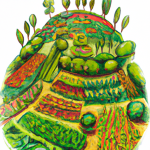
Edible and Medicinal Plants: A Guide to Self-Reliance and Survival
Picture this: society as we know it collapses. Modern conveniences vanish overnight, and accessing food and medicine becomes a daily challenge. While this may sound like a scene straight out of a post-apocalyptic movie, the truth is that it’s not entirely far-fetched. With the increasing volatility of our world, it’s crucial to be prepared for unexpected disasters or crises.
In times of uncertainty, knowledge of edible and medicinal plants can be a lifesaver. Learning to identify, harvest, and utilize these natural resources is an essential skill for anyone aiming to become self-reliant and resilient. In this guide, we’ll delve into the world of lesser-known edible and medicinal plants, equipping you with the knowledge you need to survive and thrive.
Identifying Edible Plants
In a crisis situation, finding food may become a matter of life and death. Familiarizing yourself with wild edible plants in your area is fundamental to ensuring your survival. Here are a few tips to get you started:
1. **Botanical Identification:** Invest time in learning how to identify the various plants in your surroundings. Field guides and local foraging groups can be invaluable resources.
2. **Tell-Tale Signs:** Look for distinctive features such as leaves, flowers, and fruit. Pay attention to plant growth patterns and any unique characteristics that set them apart.
3. **Universal Edibles:** Some edible plants are commonly found across different regions. Examples include dandelions, plantain, nettles, and purslane. Learn to identify these universal edibles first.
4. **Conduct a Patch Test:** Before consuming any edible plant, conduct a patch test by rubbing a small amount on your skin and waiting 24 hours. If you experience any adverse reactions, avoid eating that plant.
5. **Practice Proper Harvesting:** When collecting edible plants, do so sustainably. Only take what you need, leaving enough to allow for natural regeneration and the survival of the species.
Utilizing Medicinal Plants
In addition to providing sustenance, plants can also be used for their medicinal properties. When traditional medical resources become scarce, knowing how to utilize medicinal plants can make a significant difference in your health and well-being. Consider the following:
1. **Research and Training:** Expand your knowledge by studying herbal medicine and attending workshops or courses on medicinal plants. Make sure to learn from reputable sources to avoid misinformation.
2. **Phytochemical Properties:** Understand the different phytochemical properties of plants to create effective remedies. Some plants possess antibacterial, antifungal, anti-inflammatory, or analgesic properties.
3. **Harvest and Prepare:** Harvest medicinal plants at the right time, usually when the active compounds are most concentrated. Learn proper drying and preparation techniques to maximize their potency.
4. **Experiment with Practical Remedies:** Start with simple remedies such as herbal teas, poultices, or tinctures. Explore the healing potential of plants for various ailments like coughs, wounds, digestive issues, or anxiety.
5. **Consider Allergies and Side Effects:** As with any medication, be aware of potential allergies or side effects of medicinal plants. Always start with small doses and monitor your body’s response before increasing intake.
An Ongoing Journey to Self-Reliance
Remember, becoming self-reliant and knowledgeable about edible and medicinal plants is a lifelong journey. Continuously expanding your skill set, connecting with like-minded individuals, and experimenting with new plants and remedies will further enhance your self-sufficiency.
By developing these crucial skills, you are empowering yourself to thrive in even the most challenging situations. Don’t let fear paralyze you; let it motivate you to take action. Embrace the potential that lies within nature’s pharmacy and the abundance of edible plants around you. Your self-reliance journey begins now.



GIPHY App Key not set. Please check settings